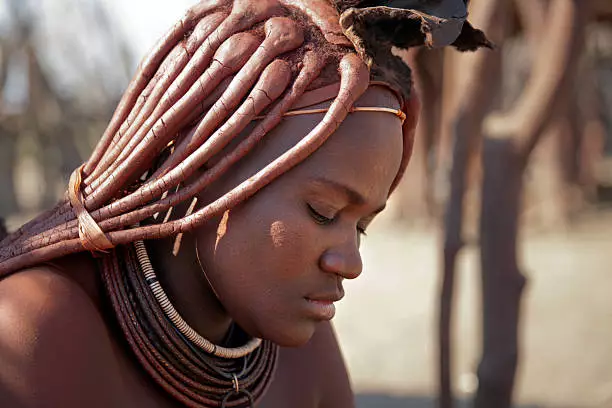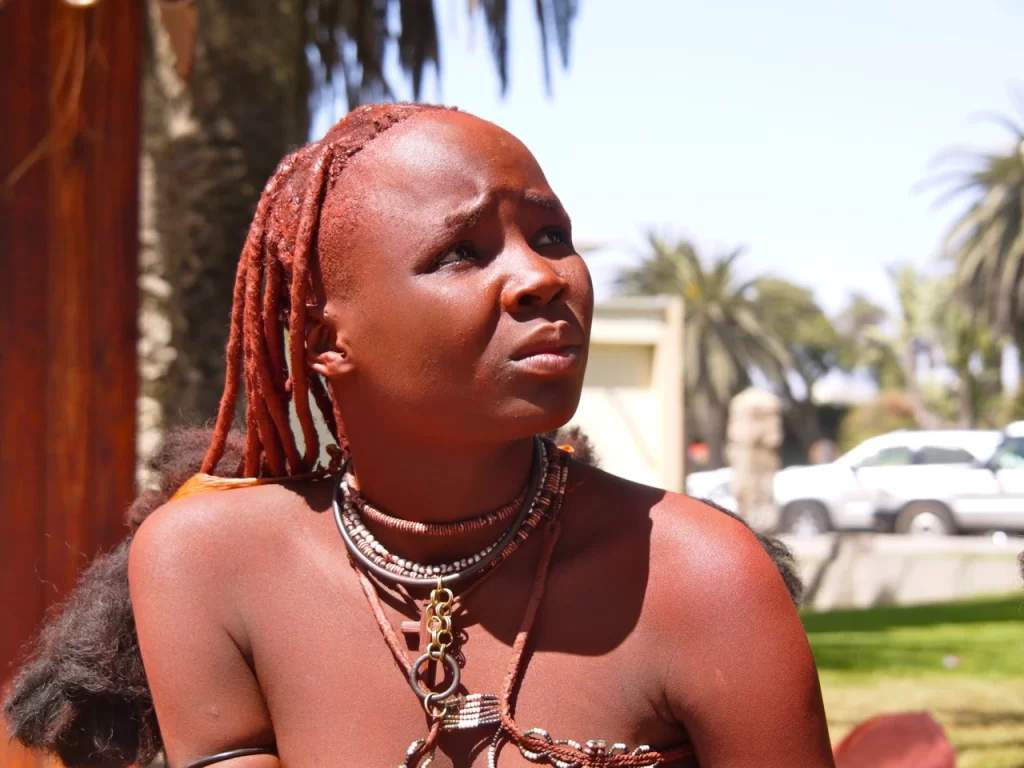Hailing from Northern Namibia Kunene Region is a very interesting community, the Himba people. They are a semi-nomadic tribe that survived genocide, and epidemics that have refused to bow to modernization.
The Himba, also known as Ovahimba, are a community of around 50,000 people from Southern Angola. They are hunters and gatherers who are popularly known for their red knotted braids. Some of the fascinating facts about the Himba people are their traditional beliefs, unique food and hairstyle and the way they treat their visitors.
The Himba people have a wonderful social and cultural life. They hold dearly to their cultural beliefs despite some members of the Himba people having enrolled their children in schools and are in contact with urban life.

Are The Himba People Herero?
Both the Himba and The Herero are Bantus who came from East Africa many years ago. Initially, the Himba and Herero were one large community who in the 1800’s separated. The larger group that moved to the south is popularly known as the Herero and the remaining group formed the ancestral group of the Himba people.
The Herero have slight differences from the Himba in terms of their cultural beliefs. They share unique hairstyle, language and spiritual beliefs. In fact, Himba is a sub-tribe of Herero.
What Is Important To The Himba People?
The Himba value so much their cultural way of living, which includes their social life, distinct hairstyle, food and religion.
Religious beliefs
The Himba believe in a supreme god called Mukuru whom they communicate through the holy fire known as Okuruwo which represents ancestral protection. Similarly, they worship their ancestors, who act as Mukuru’s mouthpiece.
In each homestead, there is an ancestral fire that never goes off to keep demons and calamities away. The Okuruwo is lit at the center of the village near the hut of the headman and is kept by the eldest woman in the village.
Outsiders and uninvited guests do not cross the holy line which begins from the main entrance and passes through the chief’s hut to the entrance of the cow pen.
The fire-keeper attends to the fire for seven to eight days for constant communication with the ancestors on behalf of the family. The Himba believe that when the smoke rises, there is continuous communication with the ancestors who intercede for them to Mukuru.
Smoke bath
 apply Red Clay Soil ” class=”wp-image-3117″ />
apply Red Clay Soil ” class=”wp-image-3117″ />Smoke baths are one of the most captivating facts about the Himba people. Women are not allowed to use water for bathing or washing their clothes. This is a cultural practice that reminds them of a time in the past where water was scarce and only men were permitted to bathe.
The Himba women mix smoldering charcoal with herbs in a small bowl and wait for the smoke to start ascending, then bow over the smoking bowl. They cover themselves with a blanket to trap the smoke from the bowl for a full body wash.
Food
Porridge is the main meal for the Himba people. The porridge is made from maize flour or pearl millet flour. Sometimes they add some cooking oil, and salt to the porridge.
The Himba usually eat meat during ceremonies, though their men can eat meat that is specifically reserved for them.
Jewelry
The Himba people adorn different jewelry in relation to their customs, whereby men and women wear arm bracelets and big necklaces. They make the necklaces from cloth, grass, ostrich eggshells and copper.
Traditional Practices
The Himba arrange their villages in a circular shape and fence using mopane branches. The huts are in a conical shape. You can access the village through an opening on the side.
Women usually perform most of the duties including plastering the huts with cow dung and red clay soil. They also collect firewood, fetch water, take care of calabash vines, make clothing and jewelry, cook and serve food, milk cows and goats and take care of children.
One more interesting thing to note about the Himba women is taking care of each other’s children. Similarly, Himba men also give their wives off to visitors to spend a night with them to show their approval and pleasure.
What Are The Himba People Known For?
The Himba people are well known for their unique red hairstyle. There are different hairstyles for men, women and children. Himba young men wear a braid that falls to the back of their head, while men of marriageable age wear two braids with a headdress which is made from fabric and decorated with ornaments.
Young girls before puberty wear long plaits in different styles. After puberty, there is a ceremony done marking the transition called ‘ekori’ whereby they receive a headdress made of sheep or goatskin and beautifully decorated iron beads.
After the marriage of the girls, the ekori is replaced with ‘erembe’. The erembe is a headdress made from the skin of a goat’s head, which is secured by two thongs at the back of the head. From then on, the ekori is kept to be worn during ceremonies only.
Do The Himba People Marry People Outside Of Their Tribe?
The Himba people are polygamous. They marry off their daughters to partners chosen by their parents. Himba men marry in their late 20s while women are married off at a very young age; after puberty.
Women have no choice of partners but men can choose who they want to marry. The men can marry more than one spouse. It is very rare for the Himba people to marry outside their tribe.
Can Tourists Visit The Himba Tribe?
You can visit the Himba people using different tour companies. The Himba people are very hospitable people and they love photographs.
You can visit the Himba village using the Opuwo town route, which is the easiest and cheapest way. The Opuwo town is at the center of the Himba people. You can mingle easily with the Himba as they go on with their daily activities, but you should be careful to observe their cultural beliefs.
